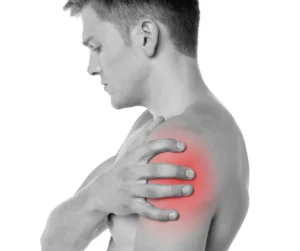Shoulder Pain Relief
Rediscover a life of strength, flexibility, and movement without shoulder pain.
Rediscover Life Without Shoulder Pain
The shoulder is a marvel of mobility, but that freedom of movement comes with a trade-off: vulnerability. When pain, weakness, or instability strikes, it can impact nearly every aspect of your active Bend lifestyle. Suddenly, simple movements become calculated risks.
This is where expert care makes all the difference. At PhysioFIT, we understand the complex mechanics of the shoulder joint. Our physical therapists provide a comprehensive evaluation to identify the underlying issue, then build a personalized treatment plan to restore your strength, stability, and pain-free range of motion.

PhysioFit Discovery Call!
Get Lasting Relief from Shoulder Pain. Call Us Today!
Common Symptoms of Shoulder Pain
- Heat or a reddened appearance in your shoulder.
- Restricted arm mobility.
- Stiffness and reduced strength in your muscles.
- A sensation of clicking, popping, or grinding during arm movements.

The Most Common Causes of Shoulder Pain
The shoulder is a complex joint, and it’s susceptible to a variety of injuries and conditions. Here are some of the most common causes of shoulder pain:
Dislocation
This happens when the top of your arm is pulled back excessively or rotated too far, causing it to pop out of its socket. Symptoms include pain, weakness, swelling, numbness, and bruising in the shoulder.
Separation
This injury affects the acromioclavicular (AC) joint, where the collarbone and shoulder blade meet. A hard blow or fall can tear the ligaments, leading to a visible bump on top of your shoulder due to a displaced collarbone.
Fracture
A fall or severe blow can result in a broken or cracked bone. The clavicle (collarbone) and humerus (upper arm bone) are most prone to fractures, leading to intense pain, bruising, and restricted movement.
Cartilage Tear
Repeated motion, a fall, or a significant force can damage the cartilage that cushions your shoulder joint. Symptoms include pain during overhead reach, shoulder weakness, and a sensation of catching, locking, or grinding.
Referred Pain
Shoulder pain doesn’t always start in the shoulder itself. It can be a symptom of an issue originating from another area, like your neck, and often feels like a steady ache that doesn’t worsen when you lift or move your arm.
Rotator Cuff Tear
The group of muscles and tendons comprising your rotator cuff secure your arm in place and enable overhead lifting. Overuse, falls, or natural aging can cause damage, leading to pain (particularly at night), reduced lifting ability, and a crackling sound during movement.
Frozen Shoulder
Characterized by restricted joint movement, this condition is caused by the build-up of abnormal tissue bands (adhesions) within the joint, often following pain or surgery-induced disuse.
Impingement
This occurs when the tendons of the rotator cuff are pinched between the shoulder bones, causing pain and swelling, particularly in individuals who frequently lift their arms overhead.
Bursitis
Overuse, repetitive motions, or an injury can inflame the bursa (a fluid-filled sac that cushions the joint), leading to pain, especially during shoulder movement.
Arthritis and Bone Spurs
Degenerative conditions are a common source of chronic shoulder pain. Osteoarthritis involves the wearing down of cartilage with age and use, while Rheumatoid Arthritis is an autoimmune condition. Both can cause deep joint pain and stiffness, as can bone spurs, bony growths that can irritate the rotator cuff.
Proactive Steps for Shoulder Pain Prevention
The good news is that surgery is rarely the first answer for shoulder pain. Better yet, by taking a few proactive steps, you can significantly reduce your risk of injury and keep your shoulders healthy for years to come.
Adopt Correct Exercise Habits
Ensure a proper warm-up before your workouts. Gradually ease into a sport or activity if you’ve been inactive for a while. Learn and adhere to the correct techniques of weight lifting, and avoid lifting beyond your capacity.
Maintain Overall Health
Stay in prime physical condition with regular exercise and a balanced diet. It’s not just a ticket to overall wellness, but it also helps in warding off potential injuries.
Lift Smart and Move Often
Protect your shoulders with smart movements. When lifting, use your leg strength while keeping a straight back. If you have a desk job, prevent stiffness by getting up to move and stretch for a few minutes every hour.
Prioritize Your All-Day Posture
Focus on your posture to protect your shoulders. Whether sitting or standing, keep your back straight to avoid strain. If you work at a desk, ensure your monitor is at eye level and your keyboard is positioned to prevent slouching.
Heed Your Body’s Signals
Do not dismiss shoulder discomfort that follows any activity. If the pain is intense and persistent, consult your doctor. Remember, enduring unnecessary pain might only exacerbate the situation.
Avoid Overreaching
When you need to access high places, use a step stool. Arrange frequently used items within easy reach, in lower drawers or shelves.
Please Note: The information provided on our website is intended for general education and is not a substitute for professional medical advice. Each individual’s situation and body is different. Therefore, what may work for one person may not work for another. We care about your well-being and advise you to reach out to us to discuss your specific needs before implementing any advice from our website.